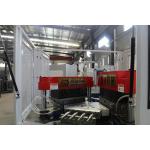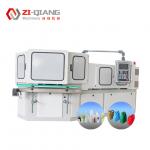Plastic injection blow molding machine is a device that integrates
injection molding and blow molding. It is mainly used to produce
hollow plastic products (such as bottles, cans, barrels, etc.). Its
characteristics cover multiple dimensions such as process,
efficiency, and product quality. The following is a detailed
description:
Process integration and efficient production
One-step molding advantage. The injection blow molding machine
completes the two processes of "injection blank" and "blow molding"
on the same equipment. There is no need to manually transfer the
blank, and the production cycle is shortened by 40%-60% (the
traditional two-step method requires the blank to be injected first
and then transferred to the blow molding machine). Case: To produce
500ml mineral water bottles, the injection blow molding machine has
a single cycle time of about 8-12 seconds, and the production
capacity can reach 3000-4500 bottles/hour, which is 1.5-2 times the
efficiency of the two-step equipment. High-precision blank control
◦ The injection system adopts a screw/plunger structure, which can
accurately control the blank weight (error ≤±0.5g) and wall
thickness distribution (such as the uniformity of the wall
thickness of the bottle mouth thread area ≤±5%), reducing the
defects of the product after blow molding (such as bottle mouth
deformation, uneven bottle body thickness)
Product quality and performance optimization
Uniform physical properties, the blank is heated evenly during the
injection process, the molecular orientation of the product after
blow molding is consistent, and the impact strength is 10%-20%
higher than that of extrusion blow molded products (such as
injection blow molded cosmetic bottles can withstand a 1.5-meter
drop without breaking). The bottle mouth thread has high precision
(matching tolerance ≤0.1mm), good sealing with the bottle cap, and
is suitable for scenes requiring high-pressure sealing (such as
carbonated beverage bottles and medicine bottles). Surface
smoothness and detail restoration ◦ The mold surface is mirror
polished (roughness Ra≤0.2μm), the surface gloss of the product can
reach more than 90%, and the text and patterns on the mold can be
clearly presented (such as the line accuracy of the bottle body
LOGO ≤0.3mm).
Material adaptability and energy saving
Compatible with a variety of plastics. Applicable materials include
thermoplastics such as PET, PP, PE, PVC, PS, etc. Some models can
process engineering plastics (such as PC, PA) to meet the needs of
different fields such as food packaging, medical equipment, and
chemical containers. For high-viscosity materials (such as PC), it
is equipped with a high aspect ratio screw (L/D=25-30) and a strong
plasticizing device to avoid material degradation. Energy-saving
design ,The servo motor drive saves 30%-50% energy compared to the
traditional hydraulic system (such as a 100-ton injection blow
molding machine with a power of about 15kW and a hydraulic machine
with a power of about 25kW), and the operating noise is reduced by
10-15dB. The heating system uses electromagnetic induction or
ceramic heating, and the thermal efficiency is increased to more
than 90%, reducing energy loss.
Automation and intelligence
Full process automation , Equipped with automatic feeding, blank
conveying, and product sorting systems, unmanned production can be
realized (such as connecting a robot to automatically take bottles,
and connecting to subsequent printing and labeling equipment). Some
high-end models support multi-cavity molding (such as 8 cavities in
one output and 16 cavities in one output), further improving
production capacity and suitable for large-scale production.
Intelligent control system Using PLC or PC-Based control system,
supporting parameter storage (can save more than 100 sets of
process recipes), one-click call when changing products, and
shortening the machine adjustment time to less than 30 minutes.
Real-time monitoring of temperature, pressure, position and
other data, and generating production reports (such as production
capacity, defective rate, energy consumption statistics) to
facilitate quality traceability and cost control.
Mold and maintenance convenience
Quick mold change design, the mold adopts hydraulic or electric
quick locking device, the mold change time is ≤1 hour (traditional
models require 2-3 hours), suitable for multi-variety small batch
production switching. The mold has a long life and can reach more
than 1 million times under normal use (injection mold cavity wear
≤0.05mm). Easy-to-maintain structure ◦ Key components (such as
screws and barrels) adopt modular design, which is easy to
disassemble and has low maintenance costs; the lubrication system
automatically supplies oil at a fixed time to reduce manual
maintenance workload.
Application scenarios and limitations
Applicable scenarios: High precision requirements: medical bottles
(need sterile sealing), cosmetic bottles (high appearance
requirements), food packaging bottles (such as sauce bottles, oil
bottles). Small hollow products: The capacity is usually
1ml-2000ml, and some large equipment can produce barrel products
above 5L. Limitations: The equipment cost is relatively high
(30%-50% more expensive than extrusion blow molding machines), and
is suitable for scenarios with high requirements for product
precision and production capacity; It is not suitable for the
production of extra-large or extremely complex-shaped products
(such as trash cans, car fuel tanks, etc., which are more suitable
for extrusion blow molding or injection molding).









